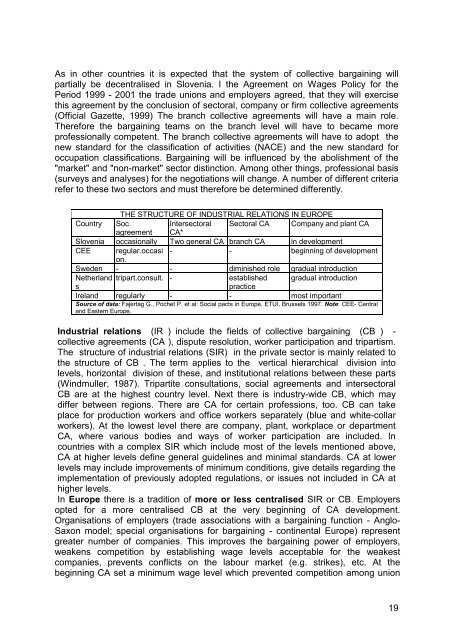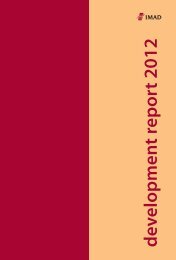The Development of New Industrial Relations in Slovenia - UMAR
The Development of New Industrial Relations in Slovenia - UMAR
The Development of New Industrial Relations in Slovenia - UMAR
Create successful ePaper yourself
Turn your PDF publications into a flip-book with our unique Google optimized e-Paper software.
As <strong>in</strong> other countries it is expected that the system <strong>of</strong> collective barga<strong>in</strong><strong>in</strong>g will<br />
partially be decentralised <strong>in</strong> <strong>Slovenia</strong>. I the Agreement on Wages Policy for the<br />
Period 1999 - 2001 the trade unions and employers agreed, that they will exercise<br />
this agreement by the conclusion <strong>of</strong> sectoral, company or firm collective agreements<br />
(Official Gazette, 1999) <strong>The</strong> branch collective agreements will have a ma<strong>in</strong> role.<br />
<strong>The</strong>refore the barga<strong>in</strong><strong>in</strong>g teams on the branch level will have to became more<br />
pr<strong>of</strong>essionally competent. <strong>The</strong> branch collective agreements will have to adopt the<br />
new standard for the classification <strong>of</strong> activities (NACE) and the new standard for<br />
occupation classifications. Barga<strong>in</strong><strong>in</strong>g will be <strong>in</strong>fluenced by the abolishment <strong>of</strong> the<br />
"market" and "non-market" sector dist<strong>in</strong>ction. Among other th<strong>in</strong>gs, pr<strong>of</strong>essional basis<br />
(surveys and analyses) for the negotiations will change. A number <strong>of</strong> different criteria<br />
refer to these two sectors and must therefore be determ<strong>in</strong>ed differently.<br />
THE STRUCTURE OF INDUSTRIAL RELATIONS IN EUROPE<br />
Country Soc.<br />
Intersectoral Sectoral CA Company and plant CA<br />
agreement CA*<br />
<strong>Slovenia</strong> occasionally Two general CA branch CA <strong>in</strong> development<br />
CEE regular.occasi - - beg<strong>in</strong>n<strong>in</strong>g <strong>of</strong> development<br />
on.<br />
Sweden - - dim<strong>in</strong>ished role gradual <strong>in</strong>troduction<br />
Netherland tripart.consult. - established gradual <strong>in</strong>troduction<br />
s<br />
practice<br />
Ireland regularly - - most important<br />
Source <strong>of</strong> data: Fajertag G., Pochet P. et al: Social pacts <strong>in</strong> Europe. ETUI, Brussels 1997. Note: CEE- Central<br />
and Eastern Europe.<br />
<strong>Industrial</strong> relations (IR ) <strong>in</strong>clude the fields <strong>of</strong> collective barga<strong>in</strong><strong>in</strong>g (CB ) -<br />
collective agreements (CA ), dispute resolution, worker participation and tripartism.<br />
<strong>The</strong> structure <strong>of</strong> <strong>in</strong>dustrial relations (SIR) <strong>in</strong> the private sector is ma<strong>in</strong>ly related to<br />
the structure <strong>of</strong> CB . <strong>The</strong> term applies to the vertical hierarchical division <strong>in</strong>to<br />
levels, horizontal division <strong>of</strong> these, and <strong>in</strong>stitutional relations between these parts<br />
(W<strong>in</strong>dmuller, 1987). Tripartite consultations, social agreements and <strong>in</strong>tersectoral<br />
CB are at the highest country level. Next there is <strong>in</strong>dustry-wide CB, which may<br />
differ between regions. <strong>The</strong>re are CA for certa<strong>in</strong> pr<strong>of</strong>essions, too. CB can take<br />
place for production workers and <strong>of</strong>fice workers separately (blue and white-collar<br />
workers). At the lowest level there are company, plant, workplace or department<br />
CA, where various bodies and ways <strong>of</strong> worker participation are <strong>in</strong>cluded. In<br />
countries with a complex SIR which <strong>in</strong>clude most <strong>of</strong> the levels mentioned above,<br />
CA at higher levels def<strong>in</strong>e general guidel<strong>in</strong>es and m<strong>in</strong>imal standards. CA at lower<br />
levels may <strong>in</strong>clude improvements <strong>of</strong> m<strong>in</strong>imum conditions, give details regard<strong>in</strong>g the<br />
implementation <strong>of</strong> previously adopted regulations, or issues not <strong>in</strong>cluded <strong>in</strong> CA at<br />
higher levels.<br />
In Europe there is a tradition <strong>of</strong> more or less centralised SIR or CB. Employers<br />
opted for a more centralised CB at the very beg<strong>in</strong>n<strong>in</strong>g <strong>of</strong> CA development.<br />
Organisations <strong>of</strong> employers (trade associations with a barga<strong>in</strong><strong>in</strong>g function - Anglo-<br />
Saxon model; special organisations for barga<strong>in</strong><strong>in</strong>g - cont<strong>in</strong>ental Europe) represent<br />
greater number <strong>of</strong> companies. This improves the barga<strong>in</strong><strong>in</strong>g power <strong>of</strong> employers,<br />
weakens competition by establish<strong>in</strong>g wage levels acceptable for the weakest<br />
companies, prevents conflicts on the labour market (e.g. strikes), etc. At the<br />
beg<strong>in</strong>n<strong>in</strong>g CA set a m<strong>in</strong>imum wage level which prevented competition among union<br />
19
















